
The assessments for this course are available upon request. The test used in this course is Concepts in Biology by OpenStax
- Subject:
- Biology
- Material Type:
- Activity/Lab
- Homework/Assignment
- Lecture
- Author:
- Christa Bowser
- Date Added:
- 06/30/2022

The assessments for this course are available upon request. The test used in this course is Concepts in Biology by OpenStax
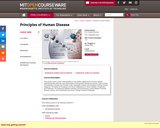
Covers current understanding of and modern approaches to human disease, emphasizing the molecular and cellular basis of both genetic disease and cancer. Specific topics include the genetics of simple and complex traits; Karyotypic analysis and positional cloning; genetic diagnosis; the roles of oncogenes and tumor suppressors in tumor initiation, progression and treatment; the interaction between genetics and environment; animal models of human disease; cancer; and conventional and gene therapy treatment strategies.

This course is designed to develop an understanding of the essentials of nutrition in regard to general health, prevention of disease and the functions of nutrients in body building. Emphasis will be placed on nutritional requirements for individuals in different stages of development, proper food selection, preparation and specific nutritional problems of our times.

This course is designed to develop an understanding of the essentials of nutrition in regard to general health, prevention of disease and the functions of nutrients in body building. Emphasis will be placed on nutritional requirements for individuals in different stages of development, proper food selection, preparation and specific nutritional problems of our times.
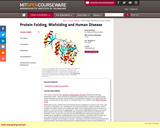
Seminar covering topics of current interest in biology. Includes reading and analysis of research papers and student presentations. Contact Biology Education Office for topics. This course is one of many Advanced Undergraduate Seminars offered by the Biology Department at MIT. These seminars are tailored for students with an interest in using primary research literature to discuss and learn about current biological research in a highly interactive setting. The instructor for this course, Dr. Kosinski-Collins, is a member of the HHMI Education Group. Maintenance of the complex three-dimensional structure adopted by a protein in the cell is vital for function. Oftentimes, as a consequence of environmental stress, genetic mutation, and/or infection, the folded structure of a protein gets altered and multiple proteins stick and fall out of solution in a process known as aggregation. In many protein aggregation diseases, incorrectly folded proteins self-associate, forming fiber-like aggregates that cause brain cell death and dementia. In this course, the molecular and biochemical basis of the prion diseases, which include bovine spongiform encephalopathy (mad cow disease), Creutzfedt-Jakob disease and kuru will be examined. Also discussed are other classes of misfolding diseases such as Alzheimer's disease and Huntington's disease. The proteins involved in all of these disorders and how the proteins' three dimensional structures change during the course of these afflictions is covered as well as why prions from certain species cannot infect animals from other species based on protein sequence and structure. The course will then address possible detection methods and therapies that are under development to treat some of the protein aggregation diseases.
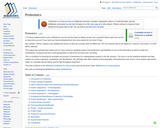
The goal of proteomics is to analyze the varying proteomes of an organism at different times, in order to highlight differences between them. Put more simply, proteomics analyzes the structure and function of biological systems. [8] For example, the protein content of a cancerous cell is often different from that of a healthy cell. Certain proteins in the cancerous cell may not be present in the healthy cell, making these unique proteins good targets for anti-cancer drugs. The realization of this goal is difficult; both purification and identification of proteins in any organism can be hindered by a multitude of biological and environmental factors. [9]
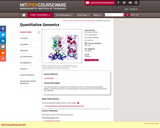
Subject assesses the relationships between sequence, structure, and function in complex biological networks as well as progress in realistic modeling of quantitative, comprehensive functional-genomics analyses. Topics include: algorithmic, statistical, database, and simulation approaches; and practical applications to biotechnology, drug discovery, and genetic engineering. Future opportunities and current limitations critically assessed. Problem sets and project emphasize creative, hands-on analyses using these concepts.
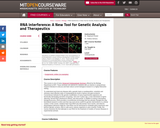
Seminar covering topics of current interest in biology. Includes reading and analysis of research papers and student presentations. Contact Biology Education Office for topics. This course is one of many Advanced Undergraduate Seminars offered by the Biology Department at MIT. These seminars are tailored for students with an interest in using primary research literature to discuss and learn about current biological research in a highly interactive setting. To understand and treat any disease with a genetic basis or predisposition, scientists and clinicians need effective ways of manipulating the levels of genes and gene products. Conventional methods for the genetic modification of many experimental organisms are technically demanding and time consuming. Just over 5 years ago, a new mechanism of gene-silencing, termed RNA interference (RNAi), was discovered. In addition to being a fascinating biological process, RNAi provides a revolutionary technology that has already changed the way biomedical research is done and that may even prove useful for genetic interventions in a clinical context. In this course, students learn how RNAi was discovered, how it works, and what its physiological relevance might be. How RNAi can be harnessed to modulate gene expression and perform genetic screens, both in cells and in various organisms is also covered. Finally, this course examines the first attempts to use RNAi for the treatment of models of human diseases in experimental animals.
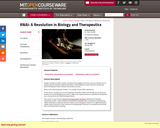
"Despite centuries of effort, modern medicine still struggles to find the source of disease and to provide specific treatment without side effects. Both traditional small molecules and protein-based therapeutics have achieved only limited success. What is the next therapeutic frontier? The answer may be RNA interference. In this course, we will focus on the therapeutic potential of RNAi. We will discuss its discovery functions in normal biological processes, utility as an experimental tool, potential for therapeutic use, and pursuit by the biotechnology industry. This course is one of many Advanced Undergraduate Seminars offered by the Biology Department at MIT. These seminars are tailored for students with an interest in using primary research literature to discuss and learn about current biological research in a highly interactive setting. Many instructors of the Advanced Undergraduate Seminars are postdoctoral scientists with a strong interest in teaching."
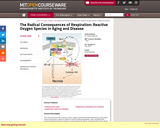
This course will start with a survey of basic oxygen radical biochemistry followed by a discussion of the mechanisms of action of cellular as well as dietary antioxidants. After considering the normal physiological roles of oxidants, we will examine the effects of elevated ROS and a failure of cellular redox capacity on the rate of organismal and cellular aging as well as on the onset and progression of several major diseases that are often age-related. Topics will include ROS-induced effects on stem cell regeneration, insulin resistance, heart disease, neurodegenerative disorders, and cancer. The role of antioxidants in potential therapeutic strategies for modulating ROS levels will also be discussed.This course is one of many Advanced Undergraduate Seminars offered by the Biology Department at MIT. These seminars are tailored for students with an interest in using primary research literature to discuss and learn about current biological research in a highly interactive setting. Many instructors of the Advanced Undergraduate Seminars are postdoctoral scientists with a strong interest in teaching.
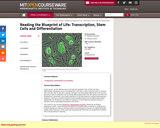
In this course, we will address how transcriptional regulators both prohibit and drive differentiation during the course of development. How does a stem cell know when to remain a stem cell and when to become a specific cell type? Are there global differences in the way the genome is read in multipotent and terminally differentiated cells? We will explore how stem cell pluripotency is preserved, how master regulators of cell-fate decisions execute developmental programs, and how chromatin regulators control undifferentiated versus differentiated states. Additionally, we will discuss how aberrant regulation of transcriptional regulators produces disorders such as developmental defects and cancer. This course is one of many Advanced Undergraduate Seminars offered by the Biology Department at MIT. These seminars are tailored for students with an interest in using primary research literature to discuss and learn about current biological research in a highly interactive setting. Many instructors of the Advanced Undergraduate Seminars are postdoctoral scientists with a strong interest in teaching.
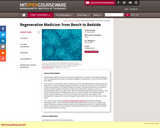
"Regenerative medicine involves the repair and regeneration of tissues for therapeutic purposes, such as replacing bone marrow in leukemia, cartilage in osteoarthritis or cells of the heart after a heart attack. In this course, we will explore basic mechanisms of how cells differentiate into specific tissues in response to a variety of biologic signaling molecules. We will discuss the use of such factors for in vitro tissue production. We will also study the cellular mechanisms involved in the cloning of animals and how Scottish researchers produced the sheep Dolly using the nucleus of a mammary gland cell from an adult sheep. We will read papers describing organ production, such as the in vitro formation of beating heart cells. We will also consider the molecular bases of cellular tissue remodeling to correct these changes. We will discuss how studies of the developmental, cellular and molecular biology of regeneration have led to the discovery of new drugs. This course is one of many Advanced Undergraduate Seminars offered by the Biology Department at MIT. These seminars are tailored for students with an interest in using primary research literature to discuss and learn about current biological research in a highly interactive setting. Many instructors of the Advanced Undergraduate Seminars are postdoctoral scientists with a strong interest in teaching."
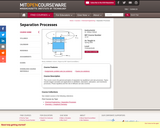
General principles of separation by equilibrium and rate processes. Staged cascades. Applications to distillation, absorption, adsorption, and membrane processes. Phase equilibria and role of diffusion. 10.32 will be offered for 6 units starting spring 2004.
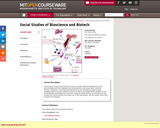
Discusses social, ethical and clinical issues associated with the development of new biotechnologies and their integration into clinical practice. Basic scientists, clinicians, bioethicists, and social scientists present on four general topics: changing political economy of biotech research; problems associated with the adaption of new biotechnologies and findings from molecular biology for clinical settings; the ethical issues that emerge from clinical research and clinical use of new technologies; and the broader social ethics associated with investigations of population genetics and social problems. Use of cases and recent literature.
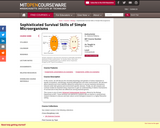
In this course, we will discuss the microbial physiology and genetics of stress responses in aquatic ecosystems, astrobiology, bacterial pathogenesis and other environments. We will learn about classical and novel methods utilized by researchers to uncover bacterial mechanisms induced under both general and environment-specific stresses. Finally, we will compare and contrast models for bacterial stress responses to gain an understanding of distinct mechanisms of survival and of why there are differences among bacterial genera.
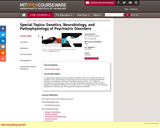
" An opportunity for graduate study of advanced subjects in Brain and Cognitive Sciences not included in other subject listings. The key topics covered in this course are Bipolar Disorder, Psychosis, Schizophrenia, Genetics of Psychiatric Disorder, DISC1, Ca++ Signaling, Neurogenesis and Depression, Lithium and GSK3 Hypothesis, Behavioral Assays, CREB in Addiction and Depressive Behaviors, The GABA System-I, The GABA System-II, The Glutamate Hypothesis of Schizophrenia, The Dopamine Pathway and DARPP32."

This activity will take students through the steps of visualizing and intepreting the distribution and spread of hte Sika Deer in Maryland using GIS with the ArcMap software application.

Statistical Physics in Biology is a survey of problems at the interface of statistical physics and modern biology. Topics include: bioinformatic methods for extracting information content of DNA; gene finding, sequence comparison, and phylogenetic trees; physical interactions responsible for structure of biopolymers; DNA double helix, secondary structure of RNA, and elements of protein folding; considerations of force, motion, and packaging; protein motors, membranes. We also look at collective behavior of biological elements, cellular networks, neural networks, and evolution.
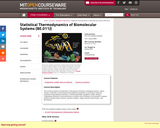
This course provides an introduction to the physical chemistry of biological systems. Topics include: connection of macroscopic thermodynamic properties to microscopic molecular properties using statistical mechanics, chemical potentials, equilibrium states, binding cooperativity, behavior of macromolecules in solution and at interfaces, and solvation. Example problems include protein structure, genomic analysis, single molecule biomechanics, and biomaterials.
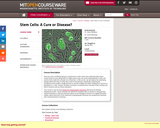
Have you ever considered going to a pharmacy to order some new cardiomyocytes (heart muscle cells) for your ailing heart? It might sound crazy, but recent developments in stem cell science have made this concept not so futuristic. In this course, we will explore the underlying biology behind the idea of using stem cells to treat disease, specifically analyzing the mechanisms that enable a single genome to encode multiple cell states ranging from neurons to fibroblasts to T cells. Overall, we hope to provide a comprehensive overview of this exciting new field of research and its clinical relevance. This course is one of many Advanced Undergraduate Seminars offered by the Biology Department at MIT. These seminars are tailored for students with an interest in using primary research literature to discuss and learn about current biological research in a highly interactive setting. Many instructors of the Advanced Undergraduate Seminars are postdoctoral scientists with a strong interest in teaching.